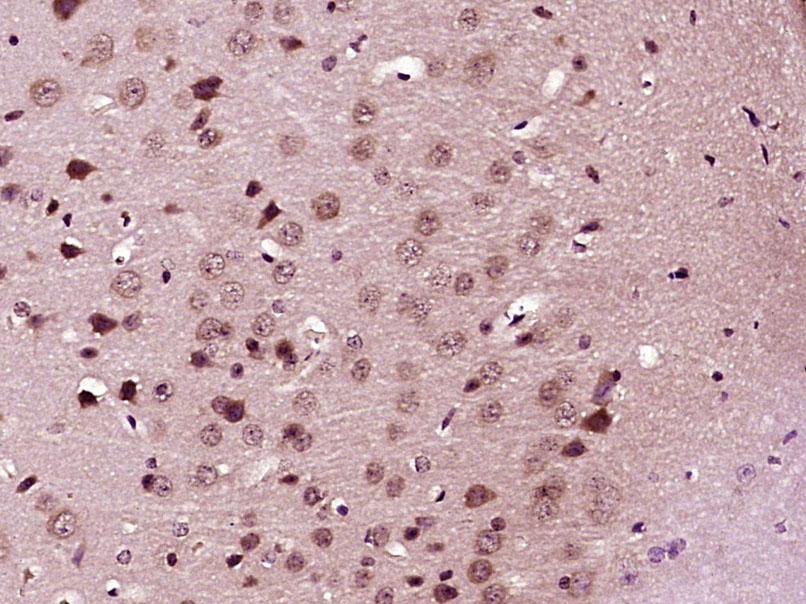
Rabbit Anti-Phospho-Aurora B (Tyr12)antibody
Aurora B (phospho Y12); AURKB_HUMAN; Aurora B (phospho T12); AIK2; AIM1; ARK2; AurB; AURKB; Aurora 1; Aurora and Ipl1 like midbody associated protein 1; Aurora kinase B; Aurora related kinase 2; Aurora-B; Aurora/IPL1 related kinase 2; IPL1; Serine/theroni
View History [Clear]
Details
Product Name Phospho-Aurora B (Tyr12) Chinese Name 磷酸化有丝分裂激酶B抗体 Alias Aurora B (phospho Y12); AURKB_HUMAN; Aurora B (phospho T12); AIK2; AIM1; ARK2; AurB; AURKB; Aurora 1; Aurora and Ipl1 like midbody associated protein 1; Aurora kinase B; Aurora related kinase 2; Aurora-B; Aurora/IPL1 related kinase 2; IPL1; Serine/theronine kinase 12; Serine/threonine protein kinase 12; STK1; STK12; STK5. Product Type Phosphorylated anti Research Area Tumour Cell biology Neurobiology Signal transduction Kinases and Phosphatases Immunogen Species Rabbit Clonality Polyclonal React Species Mouse, (predicted: Human, Rat, Pig, Cow, Horse, Sheep, ) Applications ELISA=1:5000-10000 IHC-P=1:100-500 IHC-F=1:100-500 ICC=1:100-500 IF=1:100-500 (Paraffin sections need antigen repair)
not yet tested in other applications.
optimal dilutions/concentrations should be determined by the end user.Theoretical molecular weight 39kDa Cellular localization The nucleus cytoplasmic Form Liquid Concentration 1mg/ml immunogen KLH conjugated Synthesised phosphopeptide derived from human Aurora B around the phosphorylation site of Tyr12: WP(p-Y)GR Lsotype IgG Purification affinity purified by Protein A Buffer Solution 0.01M TBS(pH7.4) with 1% BSA, 0.03% Proclin300 and 50% Glycerol. Storage Shipped at 4℃. Store at -20 °C for one year. Avoid repeated freeze/thaw cycles. Attention This product as supplied is intended for research use only, not for use in human, therapeutic or diagnostic applications. PubMed PubMed Product Detail Mahogany (MG), originally identified as a protein involved in pigmentation, acts in conjunction with melanocortin receptors to suppress diet-induced obesity. Mahogany contains a single transmembrane domain, and it is expressed in a broad range of tissues, including the hypothalamus and pigment cells. Mutations within the mahogany gene were shown to rescue agouti-lethal-yellow mutant mice from obesity. The extracellular domain of mouse mahogany is the ortholog of the human protein attractin. Attractin (also designated DPPT-L) is a human serum glycoprotein and is a member of the CUB family of cell adhesion and guidance proteins. Attractin is expressed on activated T cells and is released from the cells 48 to 72 hours after activation.
Function:
May be directly involved in regulating the cleavage of polar spindle microtubules and is a key regulator for the onset of cytokinesis during mitosis. Component of the chromosomal passenger complex (CPC), a complex that acts as a key regulator of mitosis. The CPC complex has essential functions at the centromere in ensuring correct chromosome alignment and segregation and is required for chromatin-induced microtubule stabilization and spindle assembly. Phosphorylates 'Ser-10' and 'Ser-28' of histone H3 during mitosis. Required for kinetochore localization of BUB1 and SGOL1. Interacts with INCENP.
Subcellular Location:
Nucleus. Chromosome. Chromosome > centromere. Cytoplasm > cytoskeleton > spindle. Localizes on chromosome arms and inner centromeres from prophase through metaphase and then transferring to the spindle midzone and midbody from anaphase through cytokinesis. Colocalized with gamma tubulin in the mid-body.
Tissue Specificity:
High level expression seen in the thymus. It is also expressed in the spleen, lung, testis, colon, placenta and fetal liver. Expressed during S and G2/M phase and expression is up-regulated in cancer cells during M phase.
Post-translational modifications:
Ubiquitinated by different BCR (BTB-CUL3-RBX1) E3 ubiquitin ligase complexes. Ubiquitinated by the BCR(KLHL9-KLHL13) E3 ubiquitin ligase complex, ubiquitination leads to removal from mitotic chromosomes and is required for cytokinesis. During anaphase, the BCR(KLHL21) E3 ubiquitin ligase complex recruits the CPC complex from chromosomes to the spindle midzone and mediates the ubiquitination of AURKB. Ubiquitination of AURKB by BCR(KLHL21) E3 ubiquitin ligase complex may not lead to its degradation by the proteasome.
DISEASE:
Note=Disruptive regulation of expression is a possibile mechanism of the perturbation of chromosomal integrity in cancer cells through its dominant-negative effect on cytokinesis.
Similarity:
Belongs to the protein kinase superfamily. Ser/Thr protein kinase family. Aurora subfamily.
Contains 1 protein kinase domain.
SWISS:
Q96GD4
Gene ID:
9212
Database links:Entrez Gene: 9212 Human
Entrez Gene: 20877 Mouse
Omim: 604970 Human
SwissProt: Q96GD4 Human
SwissProt: O70126 Mouse
Unigene: 442658 Human
Unigene: 3488 Mouse
Unigene: 10865 Rat
Product Picture
Bought notes(bought amounts latest0)
No one bought this product
User Comment(Total0User Comment Num)
- No comment



 +86 571 56623320
+86 571 56623320
 +86 18668110335
+86 18668110335

